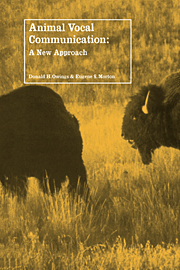Book contents
- Frontmatter
- Contents
- Preface
- Acknowledgments
- Prologue
- 1 Overview of ideas
- 2 The roles of assessment and management in communication
- 3 Form and function in vocal communication
- 4 Mechanisms and proximate processes of vocal communication
- 5 Assessment/management: a viable replacement for the information concept
- Reference
- Index
2 - The roles of assessment and management in communication
Published online by Cambridge University Press: 05 June 2012
- Frontmatter
- Contents
- Preface
- Acknowledgments
- Prologue
- 1 Overview of ideas
- 2 The roles of assessment and management in communication
- 3 Form and function in vocal communication
- 4 Mechanisms and proximate processes of vocal communication
- 5 Assessment/management: a viable replacement for the information concept
- Reference
- Index
Summary
The input of the sensory nerve is not the basis of perception as we have been taught for centuries, but only half of it. It is only the basis for passive sense impressions… The active senses cannot simply be the initiator of signals in nerve fibers or messages to the brain; instead they are analogous to tentacles and feelers [last two italics added]. And the function of the brain when looped with its perceptual organ is not to decode signals, not to interpret messages, nor to accept images. These old analogies no longer apply… The perceptual systems, including the nerve centers at various levels up to the brain, are ways of seeking and extracting information about the environment from the flowing array of ambient energy.
(Gibson, 1966, p. 5)Historical antecedents are discussed in Chapter 1. This chapter introduces what communication encompasses. Not all historical concepts and ideas described in Chapter 1 are included. The goal here is to provide a new synthesis to guide future research, emphasizing the central role that
assessment and regulatory processes play in communication.
Placing assessment on a par with management
Many species of small temperate birds form winter feeding flocks, sometimes consisting of several species (Sullivan, 1984), which they maintain by repeatedly contact calling. The downy and hairy woodpeckers, blackcapped chickadees, tufted titmice, and white-breasted nuthatches that forage together often emit such contact calls throughout the day, but may cease abruptly with signs of danger, such as when a flock member emits an antipredator call, or a hawk is detected.
- Type
- Chapter
- Information
- Animal Vocal CommunicationA New Approach, pp. 48 - 100Publisher: Cambridge University PressPrint publication year: 1998



